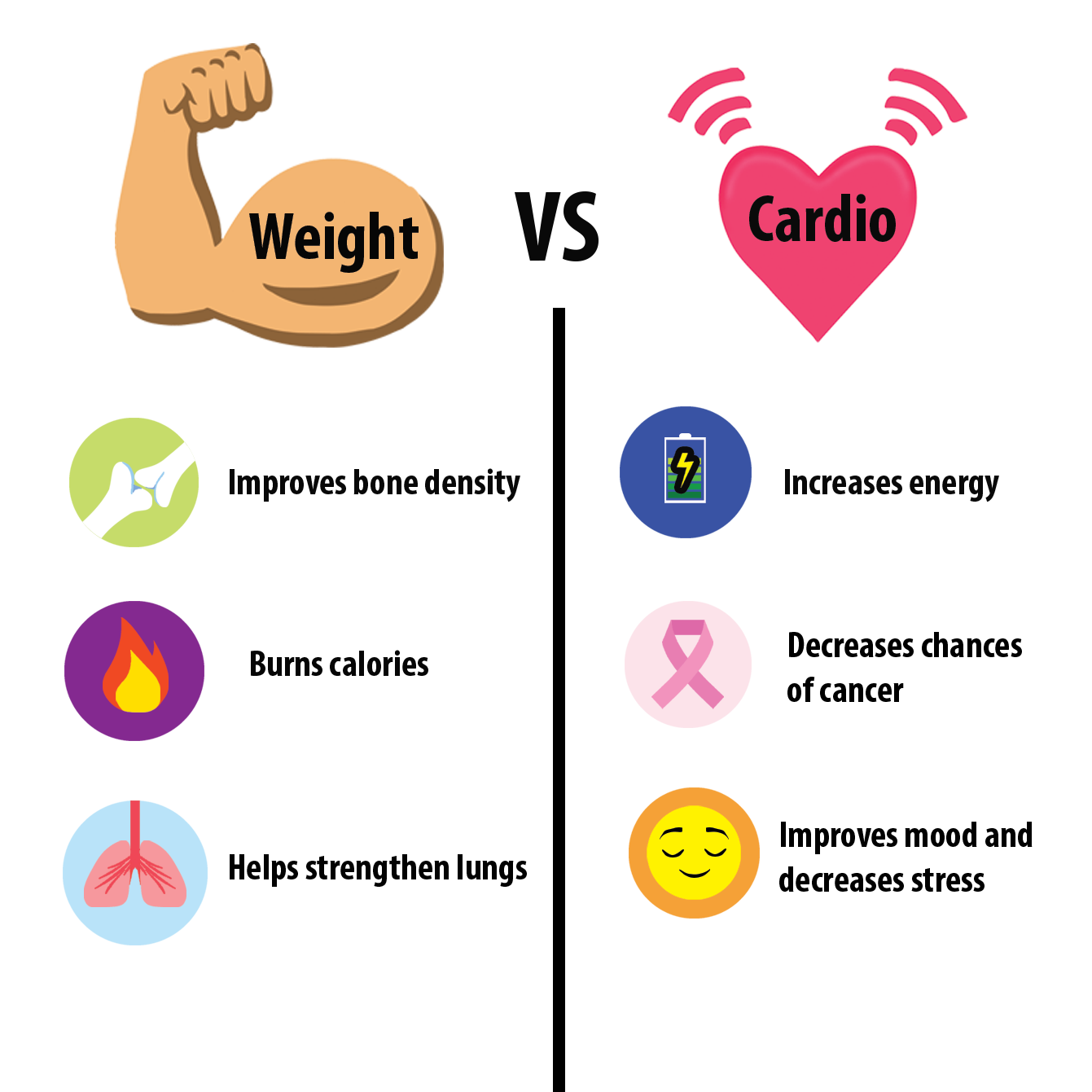Working out different training methods: Weights or Cardio
November 2, 2017
At any gym, athletes are hard at work, utilizing a variety of exercise machines. Some athletes are running and climbing stairs on treadmills, while others are lifting heavy weights with sweat beads rolling down their faces.

Cardiovascular exercises are endurance exercises that help improve the circulatory system, whereas weight training involves the strengthening of muscles. Weight training is one of the most effective ways to burn fat and lose weight, consisting of high-intensity exercises with dumbbells, exercise balls and resistance bands. Weight training requires a significantly greater level of post-exercise oxygen consumption than cardio exercises because of the resistance needed for each exercise. Studies have shown that weight training can lead to a 38 percent boost in one’s metabolism, the process in which the body converts food and water into energy. Advantages of weight training include an increase in bone density, keeping the bones strong and healthy, the building of a stronger heart and the improvement of blood flow and cholesterol levels. A long term benefit of weight training is the prevention of skeletal muscle reduction, resulting in healthier bones and a longer lifespan. Weight training also results in mental benefits such as improving one’s mood, energy and confidence, along with reducing stress and anxiety levels.
“With weights, you gain more muscles so you can look tough,” said junior Allison Lui. “However, I get really sore everywhere.”
There are disadvantages to weight training as well; for instance, it is possible to gain weight while trying to lose weight. Performing a quick and intense weight training workout can cause stress fractures, which are tiny cracks in the bone. Weight training can also be time-consuming and expensive: an extensive amount of time needs to be spent constantly exercising for visible results, and exercises require a multitude of resources, often including a gym membership and various pieces of equipment.
On the other hand, cardiovascular exercises include activities that increase one’s heart rate. These exercises strengthen the heart and increase lung capacity and metabolism. Examples of cardio exercises include running, trampolining, cycling and shadow boxing. These exercises help with reducing stress, losing weight, decreasing the risk of heart disease and minimizing the possibility of developing several types of cancer. Cardio exercises result in stress and anxiety relief as well as sleep improvement and increase in energy by pumping up endorphins, the brain’s feel-good neurotransmitters. Unlike weight training, cardio exercises do not have to be performed in the gym; walking, jogging, dancing and performing high intensity interval training (HIIT), can all be done at home.
“For cardio, in general, I feel more energized and not as sluggish,” said senior Sarah Zhang. “In terms of weight training, I feel like my muscles become more toned and strong. I would say the only problem is finding the time to do it.”
Similar to weight training, there are downsides to cardio exercises as well. Cardio exercises are not an effective way to build muscle and are effective in losing weight only when done on a regular basis. Cardio exercises can also lead to stress fractures, shin splints and other injuries.
“I do cardio exercises like various hurdle drills at the school track at least two or three times per week during track and field pre-season and the actual season,” said junior Nicole Waring. “I did a little weight freshman year but stopped after that because I didn’t find it to be very helpful for me compared to the sprinting and hurdling drills I could be doing instead.”
Although weight training and cardiovascular exercises are two exercises with different focuses, both have their benefits and disadvantages. Weight training exercises, mainly consisting of working with a variety of gym equipment, weights and heighten metabolism and prevent the reduction of skeletal muscles. However, it is easy to get injured during weight training, and a weight workout could be costly and time consuming. On the other hand, cardio exercises help participants lose weight and reduce stress and anxiety. Similar to weight training, these exercises may lead to an increase in injuries and may not necessarily result in weight loss. Despite their respective drawbacks, both are popular and effective methods of exercise.



































































